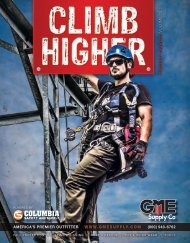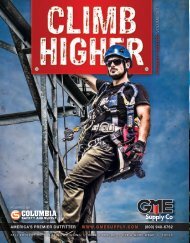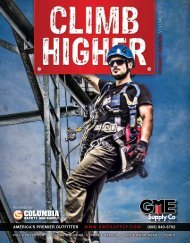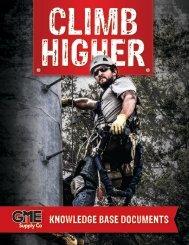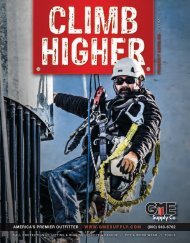GME Supply Catalog Version 20.4
GME Supply is North America's premier outfitter of fall protection, safety equipment, and gear for at-height workers, industry, and construction.
GME Supply is North America's premier outfitter of fall protection, safety equipment, and gear for at-height workers, industry, and construction.
Create successful ePaper yourself
Turn your PDF publications into a flip-book with our unique Google optimized e-Paper software.
HOW TO TO PROPERLY DON, ADJUST, AND INSPECT A FULL BODY HARNESS
FULL BODY HARNESS 101
Donning THE HARnESS
1
Untangle and VisUally
CheCk harness
Grab the harness by the dorsal D-ring
and follow the chest strap to untangle.
Closely look over the harness webbing
for abrasion, the hardware for excessive
wear, and the impact indicators to
ensure it hasn’t been in a fall.
2
don the harness
Put your arms through the
shoulder straps, like a jacket.
Don’t secure the chest strap yet.
3
adjUst From the
Bottom Up
The sub pelvic strap should rest just
below your buttocks. Raise or lower this
using torso adjusters, usually above
the waist belt.
4
ConneCt & adjUst
leg straps
These should be snug, but not overly
tight. You should be able to slide 2 or 3
fingers between your leg and the strap.
5
ConneCt & adjUst Chest
strap & waist Belt
Waist belt should be snug, but not too tight
or too loose. The chest strap should rest
directly across your chest cavity. Not too
high, not too low, but right in the sweet spot
to keep you safe.
TYpES oF connEcToRS
dorsal ConneCtion
This D-Ring is found on all ANSI harnesses.
It’s used for fall arrest and should be placed
directly between the shoulder blades.
Chest strap
Tower harnesses have another D-Ring here.
It’s the only other connection point which can
be used for fall arrest, like on a cable climb
system. Unlike the Dorsal D, fall distance must
be limited to 2 feet or less.
tongUe BUCkles
Easy operation, cannot slip once
in position.
QUiCk-ConneCt
Easiest operation, but can
occasionally require readjustment.
pass-thrU/mating
Cheapest options, hardest to use
and adjust properly.
work positioning
Side D-rings are used for work positioning.
Never fall arrest.
inSpEcTing THE HARnESS
Visually inspect these key areas of the harness every time, prior to beginning work. If you find any of these
problems, take the harness out of service.
weBBing
Cuts, tears, excess abrasion, holes, discoloration, UV damage, heat damage, welding slag, chemical
damage, hard spots
stitChing
Damaged stitching, broken thread, pulls and loose stitches, missing sections
d-rings, hardware, & BUCkles
Deformity, corrosion and rust, major nicks and dings, excess wear, proper operation
impaCt indiCators
Deployed impact indicators, broken D-ring plates, deformed grommets
laBels
Manufacturer, date of manufacture, inspection log, model, series, warnings
seat sling
A seat is a common feature on tower harnesses,
and if you’re working in suspension, you’ll
be glad you have one. Look for features like
additional tool loops or aluminum reinforcement.
D-Rings can be connected using a spreader bar.
PURCHASE THE
19” x 27” POSTER FOR
$4.99
PART # 2201











